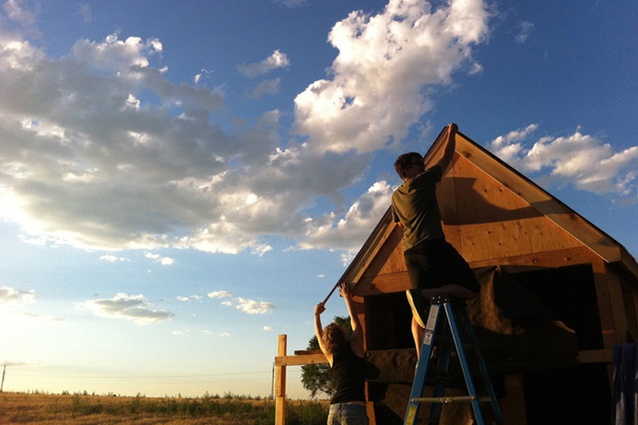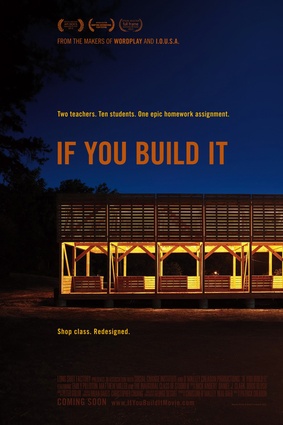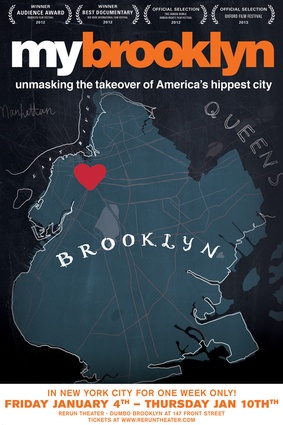Film for thought
The 2014 Resene Architecture & Design Film Festival (RADFF) has been serving up a soupcon of architectural placemarkers, conundrums and assorted responses. Stephen Olsen sampled some of the quest-fuelled screen fare on show.
Setting aside six hours to take in four consecutive documentaries at this year’s RADFF – TINY, If You Build It, My Brooklyn, Ekumenopolis – proved to be a tall but thought-provoking order to fill.
Of the movies that were products of the USA, all three set out to capture diverse attempts there to push back on pressures to cave in to accepted or enforced norms.
The smallest victory was TINY, the self-made tale of a young couple joined by a childhood dream to build a cabin in the mountains.
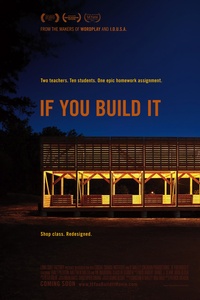
Moving between a straight smartphone-assisted buildalogue on the one hand, and an homage to a ‘building movement’ on the other, TINY portrayed the successful efforts of transient novice Christopher Smith to “create a tiny point of orientation” in the shape of his trailer mounted “tiny house” over the space of one year and a cost of about US$26,000.
Whether a rebellion against the commercialisation of every aspect of the home or more simply a square-foot solution to sidestepping “a mortgage, a marriage and a car in the driveway”, the radical down-sizing on show was fully explored as much for its hoped impact on future building patterns and the “scale of liveability” we choose, as for its status as a ‘trend’.
A procession of converts testified to the dignity of fitting into a compulsorily decluttered life as a “way to access who I am in a different way”. It might not put the small back in small-town America but it was a start.
“This isn’t my consolation prize, it’s exactly what I want,” said one. “Property owning isn’t the only route to standing and stature,” said another. Whittling down to the basics was elevated to being a “cultural invitation to humility”.
Having achieved the placement of their showcase all-in-one structure on a breath-taking high-mountain Colorado prairie, Smith and Merete Mueller won on another front: they had also travelled some way towards realising a “liberation from dead-end choices”.
If You Build It similarly pushed up against dead-end choices, this time in Bertie County, in the poorest part of North Carolina.
Before they had even ignited their Studio H design-and-build workshops with a grateful set of high school students, designer-activists Emily Pilloton and Matthew Miller hit a dead-end with a high school board too short-sighted to countenance any of their budget supporting a “different type of classroom”.
Inspiringly Miller and Pilloton kept on keeping on, and on, and on. By the time they left the settlement of Windsor their Studio H efforts had “flushed out” a farmer’s market building as a harbinger of a community that could still stand on its own two feet.
This was an unassuming yet potent example of ingenuity overcoming constraints at a very identifiable and human scale. Educationally it underlined the point made by Pilloton that “75% of the learning happens when you have to make (the design) real”.
Societally it also made the point that the bulwark of resistance to change in classrooms is built extremely high.
As a close-out to this American trilogy of sorts, My Brooklyn was a case of subversion of urban change writ large, underscored by thinly disguised racial prejudice and unmitigated greed.
At intervals of roughly four years director Kelly Anderson – herself a resident of the famous New York borough – traced the rise and rise in the takeover of downtown Brooklyn.
With vox pop and human touchstones utilised throughout – including historian Craig Steven Wilder and photographer Jamel Shabazz – Anderson exposes the block-by-block twists and turns of a so-called ‘gentrification’ within the city’s confines.
From a reading of Brooklyn’s urban history weighted more to black than white it was apparent that whole neighbourhoods and malls were only kept vibrant and viable because, in the words of one community member “we were here when nobody wanted to be here”.
Which, in another oft-repeated storyline, eventually counted for next to nothing when the property vultures descended, with rent rises and eviction notices hidden behind their backs.
As much of a fightback as could be mounted is personified through Anderson’s camera in familiar scenes of a community group (FUREE, standing for Families United for Racial and Economic Equality) speaking before impassive officials and vested interests who mouth possible compromises in return that never materialise.
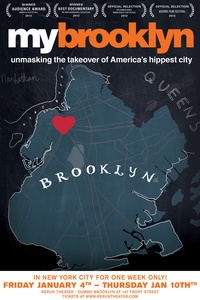
Consequently the ability of people to “put down roots let alone take part in public life” becomes less and less.
If only at the surface Anderson does a sterling job of plotting the masks worn by developers that have seen rent-stabilised housing and grassroot small businesses replaced by an out-of-scale forest of high-rise “luxury condos”. In doing so she reveals the city’s use of zoning – posited as neutral change – for its effects in displacing and segregating people.
If My Brooklyn put New York City practices in a shadowy light, then Ekumenopolis, City Without Limits from Turkish director Imre Azem put another spin on the transmission of ‘first world problems’.
The film centred on Istanbul where the cynical equivalent of tiny houses would be the city’s squatter housing (known as gecekondu) - with the occupants undoubtedly being experts in design-and-build.
This film’s fast-paced weaving together of educative spatial graphics at the macro-urban level with the political and class-infused fate of families forcibly relocated from gecekondu, but unable to afford apartment housing, couldn’t but leave a viewer reeling from the challenges facing this global mega-city at such a symbolic crossroad.
Ekumenopolis raised a palpable fear that the consequence of poor planning on the future of such a city can only be to dystopically blot out both its inhabitants and its vital natural hinterland. A fear that imposing a certain type of discredited template, made worse by being devoid of elements such as significant public transport and parks, could “eventually kill (both)”.
Aerial shots in particular displayed a finely balanced landscape being developed within an inch of its sustainable geographical capacity. Meanwhile key thinkers and players in the city’s future cast a widely contrasting set of predictions on what that future may hold, the majority with large notes of caution and concern doubly supported by the city’s vulnerability to earthquakes and floods.
High-rise apartment blocks ostensibly built for urban renewal purposes, and described by one commentator as “concrete Faraday cages”, were apparently sitting empty. Isolated tenements were becoming devalued as fast as the inhabitants of the ‘old city’ who were being victimised by their dislocation were seeking to return to and retain possession of the neighbourhoods they had been uprooted from.
As film festivals can and should do, this small sample of the 19 documentaries on offer during the 2014 RADFF, posed as many questions as directions.
A few of the ponderable questions these four films left for me were:
- Is it too late to rethink, en masse, the permissible scale of structure that makes a free-standing house both liveable and affordable?
- Wouldn’t a better future be to design an architecture that thinks big and builds small?
- Who profits if a city surpasses its naturally safe limits without any alternative centres of development?
- If a city is where poor people and different cultures live (from Ekumenopolis) what is the long-term effect of the exclusive and undemocratic triumph of luxury and wealth?

